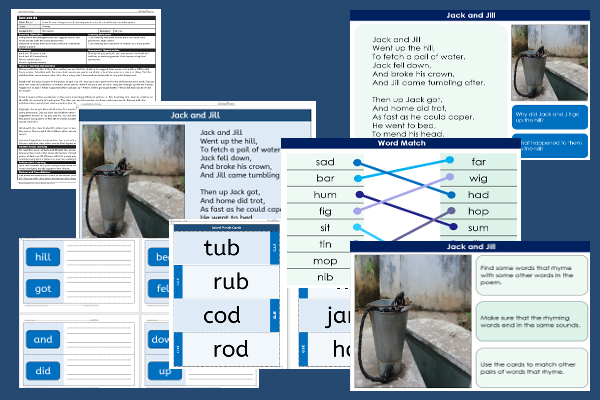Home > Foundation Stage > Literacy > Writing > Poetry > Nursery Rhymes
Jack and Jill

This literacy teaching pack for the Foundation Stage gets the children to identify and change some of the different sets of rhyming words that have been used in a traditional narrative poem of a nursery rhyme.
The class can explore and record the sequence of events in a nursery rhyme poem and suggest alternative events in the narrative with the same or different characters.
Download this teaching pack including a lesson plan, classroom activities and an interactive presentation to identify and change some of the different sets of rhyming words that have been used in a traditional narrative poem of a nursery rhyme
Activities in this teaching pack include a shared reading text to describe the content and structure of a traditional narrative poem of a nursery rhyme and sets of cards to identify, group and spell words that rhyme to match with vocabulary from a traditional narrative poem of a nursery rhyme.
The interactive presentation gets the children to explore how to change sets of rhyming words used in a traditional narrative poem of a nursery rhyme.
This lesson is part of a literacy scheme of work to get the children to identify and describe the sequence of events and characters that feature in a range of different narrative poems with rhymes. There are teaching activities for shared learning, differentiated worksheets to support independent learning and interactive presentations to introduce concepts and key skills.
-

Garden Measurements
Practise using vocabulary words and non-standard measurements to find and compare the length of different things that can found in a garden
-

Family Holiday
Identify and recount events and experiences to describe what happened when on holiday at the seaside using sentences in the past tense
-

Money Shopping
Investigate and model some of the number skills that need to be used when working with money on a shopping trip
-

Supporting Others
Explore how to build strong and positive relationships with other pupils at school and family members at home through different situations and scenarios
